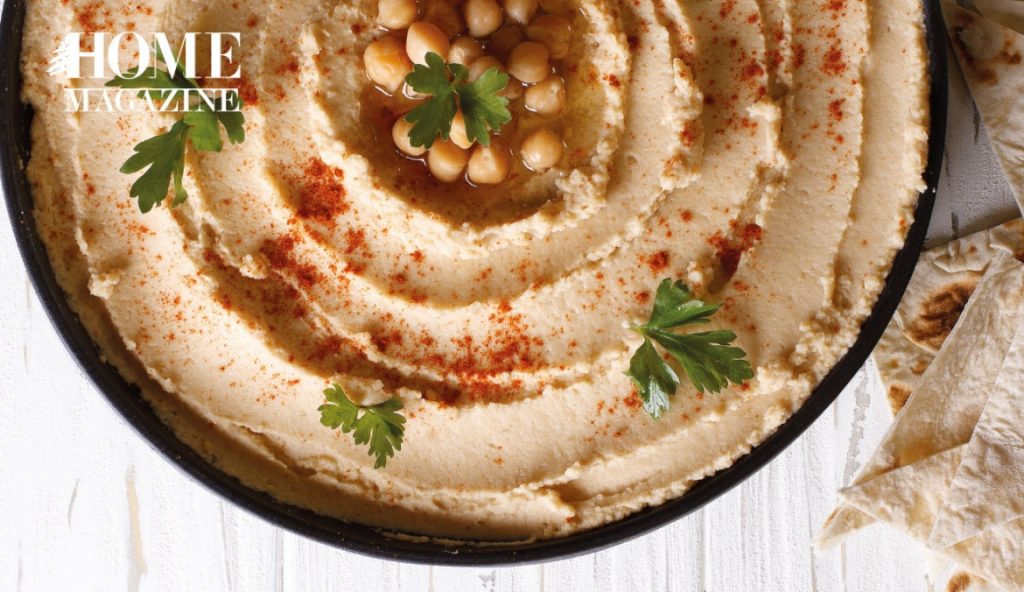Some might describe it as a creamy, savory, decadent appetizer with numerous nutritional values. Others may think of it as mesmerizing and purely satisfying to their pallet. Still others would cross heaven and hell to claim it as their own, whether you’re a native Lebanese resident or a member of the vast diaspora, one thing is certain: Hummus tastes like HOME.
HISTORY & FOLKLORE
For centuries, there has been much debate as to the roots of this essential part of the Lebanese culinary heritage. As everyone in this quaint Mediterranean country knows hummus, or hummus bi tahini, is a staple of any cold mezze or feast. Few know, however, the exact origins of the chickpea and tahini based paste or how it came to be so popular.
Hummus, literally translated as chickpea in Arabic, comprises four main ingredients chickpeas, tahini (sesame seed paste),garlic, and lemon. This flavor combination holds significant importance to Turkish, Egyptian, Syrian, and most prominently,Lebanese backgrounds. Early medieval cookbooks from 13th century Cairo and Damascus depict recipes that bear uncanny resemblances to modern-day hummus, but lack in either lemon or tahini. Extra herbs and walnuts were added to those variations, while vinegar was sometimes substituted for lemon.
Lebanon expands on ancient customs, making the creamy spread even tastier by incorporating various additions, such as olive oil, paprika, spiced ground meat, pine nuts, pomegranate seeds, and/or radish blossoms.In 2010, a group of 300 Lebanese student chefs at Al- Kafaat University in Beirut achieved the Guinness World Record for the largest serving of hummus, in an effort to put to rest any claims that hummus originated elsewhere. It weighed 10,452 kilograms and was served on a giant ceramic plate 7.17 meters in diameter.
“Whether you’re a native Lebanese resident or a member of the vast diaspora, one thing is certain: Hummus tastes like HOME.”
The truth is, there are incomplete records of hummus’ birthplace, but what is known is that the components have been used in the Eastern Mediterranean and the Middle East for thousands of years. Chickpeas and tahini have been around for roughly 10,000 years, possibly since the beginning of civilization, predating both pottery and the written word. Lemons, on the other hand, are said to have first arrived in the region in the 8th century, while garlic goes all the way back to ancient Egypt and the construction of the Pyramids of Giza.
Some explain it as one of the oldest prepared foods known to man, while it is often claimed that hummus was a common street vendor product in old Palestine and that chickpeas were one of the earliest crops in Mesopotamia. Food variations previously relied on affordability and availability. Given the arid, desert climate of one half of the region and the humid, rainy weather of the other, it’s evident that hummus was a healthy, flavorful food that traveled exceptionally well. High in fiber, iron, potassium, and Vitamin C, it is often described as a nutritionists’ miracle dish.
The historical enigma surrounding hummus laid the groundwork for what has come to be an international gastronomic phenomenon, with many expert chefs and HOMEcooks revolutionizing the procedure with ingredients that complement the original formula nicely. They substitute edamame beans, white kidney beans, avocados, and so much more for chickpeas, while they add various flavor options like roasted red pepper, zucchini, spinach, and feta.
Nowadays, Lebanese cooks have the convenience of utilizing canned chickpeas, which is a contentious issue: canned versus fresh. Most people also have a food processor somewhere in their kitchen cabinet. Traditionally, however, there was a very specific and elaborate process to preparing hummus bi tahini, one that involved a mortar and pestle.
For more info

































